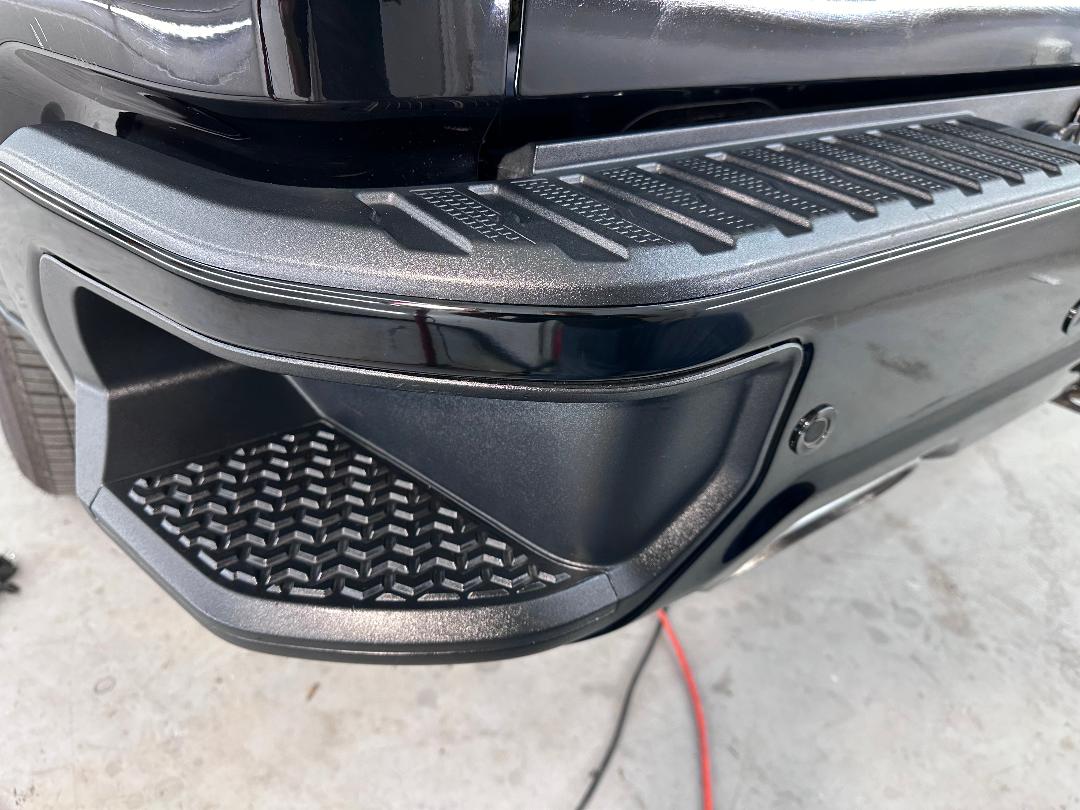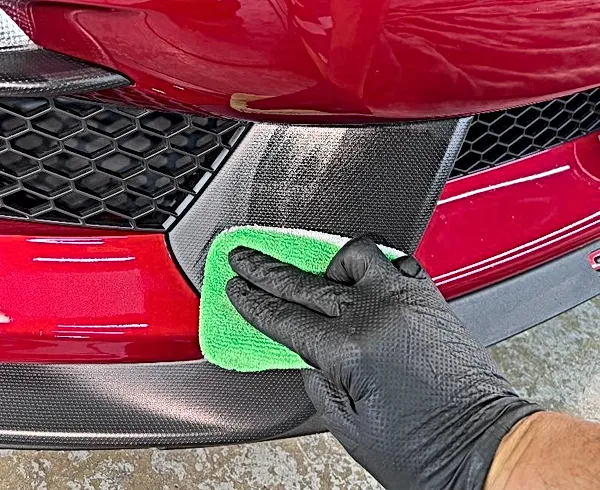Plastic Coating

Have you seen a vehicle with faded plastic parts that no longer have their original rich, black or dark gray texture? This is common, especially in older cars, and can make even well-maintained vehicles look worn and neglected.
Definition of Photodegradation
The light gray chalk color on vehicle plastics is primarily caused by prolonged exposure to UV rays and environmental factors. UV radiation from the sun accelerates the degradation of plastic materials, leading to a process called photodegradation. This process breaks down the polymers in the plastic, causing them to lose their color and become brittle over time. Additionally, environmental factors such as pollution, moisture, and temperature fluctuations can exacerbate this degradation process. As a result, the plastic surfaces on vehicles gradually lose their original color and appearance, developing a light gray chalky patina over time. Regular maintenance and protective measures, such as applying UV-resistant coatings or storing vehicles in shaded areas, can help mitigate this degradation and prolong the lifespan of plastic components.


Resolution to Preservation
Indeed, utilizing ceramic plastic coating presents a viable solution to preserve the original color and protect the appearance of vehicle plastics. This innovative coating forms a durable barrier that shields plastic surfaces from UV radiation, environmental pollutants, and other harmful factors. By applying ceramic plastic coating, we effectively mitigate degradation, prolonging the lifespan of plastic components. This protective layer not only maintains the vibrant color of the plastics but also enhances their durability and resistance to scratches and abrasions. Trust in ceramic plastic coating as a proactive measure to safeguard your vehicle's plastics, ensuring they retain their pristine appearance for years to come.
Application Process
Surface Preparation: Begin by thoroughly cleaning the plastic surfaces to remove any dirt, debris, or contaminants. This typically involves using alcohol-based solvents or cleaners to ensure a clean and smooth surface for coating application. Degreasing: Use alcohol solvents to degrease the plastic surfaces, removing any oils or residues that may affect adhesion. This step is crucial for ensuring proper bonding of the ceramic coating to the plastic substrate. Application of Ceramic Coating: Once the surface is clean and dry, apply 1-2 coats of ceramic plastic coating using a suitable applicator such as a microfiber cloth or sponge. Ensure even coverage and follow the manufacturer's instructions for application and drying times. Curing: Allow the ceramic coating to cure and bond with the plastic surface. This typically involves allowing the coating to air dry for a specified period or using heat lamps to accelerate the curing process.


Best Maintenance Practices
Regular Cleaning: Clean the coated plastics regularly using a mild soap and water solution. This helps remove any dirt, dust, or debris that may accumulate on the surface. Gentle Washing: Use a soft sponge or microfiber cloth to wash the coated plastics, avoiding abrasive materials that could scratch the surface. Avoid Harsh Chemicals: Avoid using harsh chemicals or abrasive cleaners on the ceramic-coated plastics, as these can damage the coating and compromise its effectiveness. Dry Thoroughly: After washing, dry the coated plastics thoroughly with a clean, soft towel to prevent water spots or streaks from forming. Use Ceramic Coating Maintenance Products: Consider using ceramic coating maintenance products specifically designed for plastic surfaces. These products can help enhance the protective properties of the coating and maintain its glossy finish.
-

Long Term Protection :
Plastic coatings act as a barrier against scratches, chips, and abrasions, helping to preserve the vehicle's paintwork and finish. They can shield the underlying paint from damage caused by road debris, rocks, gravel, and other hazards encountered during driving.
-

Enhanced Resale Value :
By maintaining the exterior appearance of the vehicle in pristine condition, plastic coatings can help retain its resale value. Vehicles with well-maintained paintwork are generally more attractive to potential buyers and command higher prices in the used car market.
-

UV Protection :
Plastic coatings can provide UV protection, preventing the vehicle's paint from fading or oxidizing due to prolonged exposure to sunlight. This helps to maintain the vibrancy and glossiness of the paint for a longer period.
-

Resistance to Chemicals and Stains :
Plastic coatings offer resistance to various chemicals, including detergents, solvents, and acidic substances found in bird droppings or tree sap. This protects the paint from etching or staining, ensuring that the vehicle's exterior remains pristine.
-

Ease of Cleaning :
Some plastic coatings have hydrophobic properties, meaning they repel water and other liquids. This makes it easier to clean the vehicle as dirt, grime, and contaminants are less likely to adhere to the surface. Additionally, hydrophobic coatings promote self-cleaning as water beads off the surface, carrying away dirt and debris.
-

Advance Your Car's Appearance :
Are you ready to experience the transformation that car plastic coating can bring to your vehicle? Whether it's interior panels or exterior trim, we offer protection and elegance that make your car truly exceptional. Visit us today and let your car shine!



